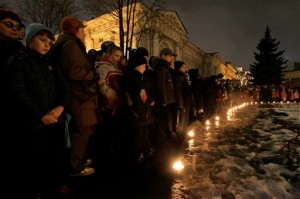

Follow us on:  
|


Celebrations to cherish the deeds of the heroes are held throughout Russia. [Getty Images]
Known as “blokada” in Russian, the siege lasted for 871 days and claimed the lives of hundreds of thousands of people, who died of starvation or bombardment.
In the framework of memorial ceremonies the youth delegates from hero-cities kicked off the project called “The race of great victories”: for two years the Victory Banner will be travelling across Russian cities to remind people about the losses in the Great Patriotic War.
In the evening Saint Petersburg will set off fireworks to commemorate the victims of World War II.
The commemorational events will be held in many other Russian cities.
Today, the blockade is part of the national memory, a feature of modern Russians cherished by generations and most likely preserved for decades to come.
And even though it is hard now to find a veteran who overcame all the ordeals of the World War II, as most of them would be over a hundred years old now; the memory of these Russians is still alive.
Celebrations to cherish the deeds of the heroes are held throughout Russia.
Today Saint Petersburg churches are serving messes and people are praying for the souls of those civilians who died in the city 70 years ago, and those who died fighting to save the besieged people.
Months after the start of the Great Patriotic War, Leningrad was encircled by the German troops and almost 3 million inhabitants of the city refused to surrender.
Suffering from consistent bombings and increasing starvation, people thrived to be set free almost 900 days after the siege started.
In the worst period ever – January 1942 – the city’s food rations reached an all-time low of 125 grams of bread per person, per day.
Provisions came sporadically via the Ladoga Lake, and over half a million of people were taken out of the city via the so-called “Road of Life” the only route connecting the city with the mainland.
Daria Chernyshova